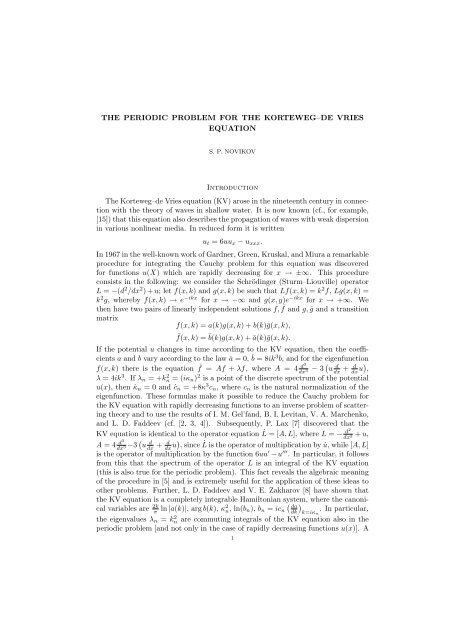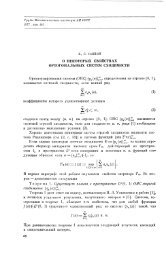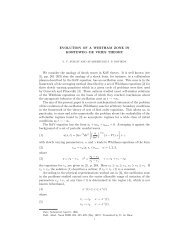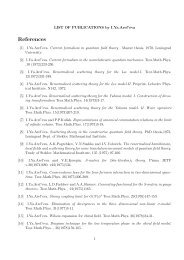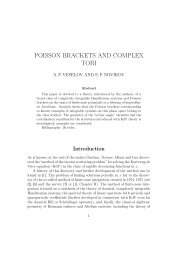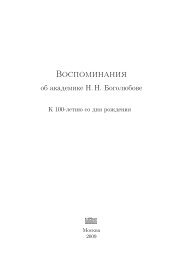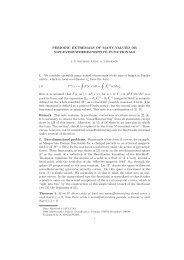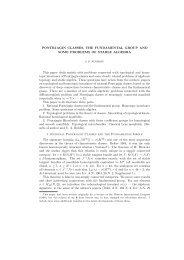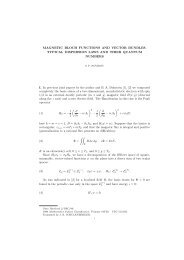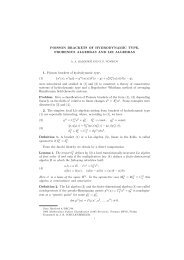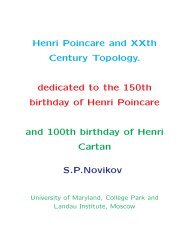A periodic problem for the Korteweg-de Vries equations, I.
A periodic problem for the Korteweg-de Vries equations, I.
A periodic problem for the Korteweg-de Vries equations, I.
Create successful ePaper yourself
Turn your PDF publications into a flip-book with our unique Google optimized e-Paper software.
THE PERIODIC PROBLEM FOR THE KORTEWEG–DE VRIESEQUATIONS. P. NOVIKOVIntroductionThe <strong>Korteweg</strong>–<strong>de</strong> <strong>Vries</strong> equation (KV) arose in <strong>the</strong> nineteenth century in connectionwith <strong>the</strong> <strong>the</strong>ory of waves in shallow water. It is now known (cf., <strong>for</strong> example,[15]) that this equation also <strong>de</strong>scribes <strong>the</strong> propagation of waves with weak dispersionin various nonlinear media. In reduced <strong>for</strong>m it is writtenu t = 6uu x − u xxx .In 1967 in <strong>the</strong> well-known work of Gardner, Green, Kruskal, and Miura a remarkableprocedure <strong>for</strong> integrating <strong>the</strong> Cauchy <strong>problem</strong> <strong>for</strong> this equation was discovered<strong>for</strong> functions u(X) which are rapidly <strong>de</strong>creasing <strong>for</strong> x → ±∞. This procedureconsists in <strong>the</strong> following: we consi<strong>de</strong>r <strong>the</strong> Schrödinger (Sturm–Liouville) operatorL = −(d 2 /dx 2 ) + u; let f(x, k) and g(x, k) be such that Lf(x, k) = k 2 f, Lg(x, k) =k 2 g, whereby f(x, k) → e −ikx <strong>for</strong> x → −∞ and g(x, y)e −ikx <strong>for</strong> x → +∞. We<strong>the</strong>n have two pairs of linearly in<strong>de</strong>pen<strong>de</strong>nt solutions f, ¯f and g, ḡ and a transitionmatrixf(x, k) = a(k)g(x, k) + b(k)ḡ(x, k),¯f(x, k) = ¯b(k)g(x, k) + ā(k)ḡ(x, k).If <strong>the</strong> potential u changes in time according to <strong>the</strong> KV equation, <strong>the</strong>n <strong>the</strong> coefficientsa and b vary according to <strong>the</strong> law ȧ = 0, ḃ = 8ik3 b, and <strong>for</strong> <strong>the</strong> eigenfunctionf(x, k) <strong>the</strong>re is <strong>the</strong> equation f ˙ = Af + λf, where A = 4 d3dx− 3 ( u d3 dx + ddx u) ,λ = 4ik 3 . If λ n = +kn 2 = (iκ n ) 2 is a point of <strong>the</strong> discrete spectrum of <strong>the</strong> potentialu(x), <strong>the</strong>n ˙κ n = 0 and ċ n = +8κ 3 c n , where c n is <strong>the</strong> natural normalization of <strong>the</strong>eigenfunction. These <strong>for</strong>mulas make it possible to reduce <strong>the</strong> Cauchy <strong>problem</strong> <strong>for</strong><strong>the</strong> KV equation with rapidly <strong>de</strong>creasing functions to an inverse <strong>problem</strong> of scattering<strong>the</strong>ory and to use <strong>the</strong> results of I. M. Gel’fand, B. I. Levitan, V. A. Marchenko,and L. D. Fad<strong>de</strong>ev (cf. [2, 3, 4]). Subsequently, P. Lax [7] discovered that <strong>the</strong>KV equation is i<strong>de</strong>ntical to <strong>the</strong> operator equation ˙L = [A, L], where L = − d2dx+ u, 2A = 4 d3dx−3 ( u d3 dx + ddx u) , since ˙L is <strong>the</strong> operator of multiplication by ˙u, while [A, L]is <strong>the</strong> operator of multiplication by <strong>the</strong> function 6uu ′ − u ′′′ . In particular, it followsfrom this that <strong>the</strong> spectrum of <strong>the</strong> operator L is an integral of <strong>the</strong> KV equation(this is also true <strong>for</strong> <strong>the</strong> <strong>periodic</strong> <strong>problem</strong>). This fact reveals <strong>the</strong> algebraic meaningof <strong>the</strong> procedure in [5] and is extremely useful <strong>for</strong> <strong>the</strong> application of <strong>the</strong>se i<strong>de</strong>as too<strong>the</strong>r <strong>problem</strong>s. Fur<strong>the</strong>r, L. D. Fad<strong>de</strong>ev and V. E. Zakharov [8] have shown that<strong>the</strong> KV equation is a completely integrable Hamiltonian system, where <strong>the</strong> canonicalvariables are 2k π ln |a(k)|, arg b(k), ( κ2 n, ln(b n ), b n = ic da)n dk k=iκ n. In particular,<strong>the</strong> eigenvalues λ n = kn 2 are commuting integrals of <strong>the</strong> KV equation also in <strong>the</strong><strong>periodic</strong> <strong>problem</strong> [and not only in <strong>the</strong> case of rapidly <strong>de</strong>creasing functions u(x)]. A1
2 S. P. NOVIKOVnumber of o<strong>the</strong>r <strong>equations</strong> have subsequently been found which admit <strong>the</strong> “Lax representation”˙L = [A, L] <strong>for</strong> a certain pair of operators A, L. P. Lax [7] and Gardner[6] have shown that <strong>the</strong> known polynomial integrals I n (u) = ∫ ∞−∞ P n(u, . . . , u (n) ) dxof <strong>the</strong> KV equation (<strong>the</strong> I n are expressed in terms of <strong>the</strong> spectrum of <strong>the</strong> operatorL) all <strong>de</strong>termine <strong>equations</strong>˙u = d δI ndx δu(x) , (1)admitting <strong>the</strong> Lax representation ˙L = [A n , L], where L = (d 2 /dx 2 ) + u and <strong>the</strong> A nare certain skew-symmetric operators of or<strong>de</strong>r 2n + 1,∫∫ ( ) uI 0 = u 2 ′2dx, I 1 =2 + u3 dx,∫ ( u′′2I 2 =2 − 5 2 u2 u ′′ + 5 )2 u4 dx,A 0 = d(dx , A 1 = 4 d3dx 3 − 3 u ddx + d )dx u ,A 2 = d5dx 5 − 5 2 u d3dx 3 − 15 d2u′4 dx 2 + 15u2 − 25u ′′ d8 dx + 15 8)(uu ′ − u′′′. (2)2We shall call <strong>the</strong>se <strong>equations</strong> “higher KV <strong>equations</strong>.” Fur<strong>the</strong>r, beginning with <strong>the</strong>papers [9, 10], a number of o<strong>the</strong>r important <strong>equations</strong> were found which admit<strong>the</strong> Lax representation ˙L = [A, L], where L is no longer a Schrödinger operator(and is not always symmetric). In <strong>the</strong> papers of L. D. Fad<strong>de</strong>ev, V. E. Zakharov,and A. B. Shabat ([10, 11, 12]) <strong>the</strong> nee<strong>de</strong>d generalization of scattering <strong>the</strong>ory wascarried out <strong>for</strong> <strong>the</strong> new operators which has ma<strong>de</strong> it possible to solve <strong>the</strong> direct andinverse <strong>problem</strong>s and to carry through <strong>the</strong> “Kruskal” integration of <strong>the</strong> Cauchy<strong>problem</strong> <strong>for</strong> rapidly <strong>de</strong>creasing (as x → ±∞) initial data. A consi<strong>de</strong>rable literaturehas recently been <strong>de</strong>voted to discovering such new <strong>equations</strong> and carrying over<strong>the</strong> Kruskal mechanism to <strong>the</strong>m. However, even <strong>for</strong> <strong>the</strong> original KV equation <strong>the</strong><strong>periodic</strong> <strong>problem</strong> has not moved <strong>for</strong>ward. The only new result in <strong>the</strong> <strong>periodic</strong> case,which was obtained by <strong>the</strong> method of Gardner, Green, Kruskal, and Miura, is <strong>the</strong><strong>the</strong>orem of Fad<strong>de</strong>ev and Zakharov to <strong>the</strong> effect that <strong>the</strong> eigenvalues of <strong>the</strong> operatorL are commuting integrals of <strong>the</strong> KV equation as a Hamiltonian system (we remarkthat <strong>the</strong> integrals <strong>the</strong>mselves can be expressed in a one-to-one manner in terms of<strong>the</strong> previously known polynomial integrals I n which are thus also involutive). Thisresult has not been used in an essential way until <strong>the</strong> present work, but here itplays an important role (cf. §2).The interaction of simple waves [solutions of <strong>the</strong> type u(x − ct), usually called“solitons”] are of major interest in <strong>the</strong> <strong>the</strong>ory of <strong>the</strong> KV equation. This interactionis <strong>de</strong>scribed by means of so-called “multisoliton solutions” where b(k) ≡ 0 <strong>for</strong> realk. 1 These solutions <strong>de</strong>cay into solitons <strong>for</strong> x, t → ±∞ and <strong>de</strong>scribe <strong>the</strong>ir interaction<strong>for</strong> finite t. For this case <strong>the</strong> Gel’fand–Levitan <strong>equations</strong> are completely solvable(cf., <strong>for</strong> example [8, 9]). Ano<strong>the</strong>r method of obtaining multisoliton solutions hasbeen <strong>de</strong>veloped in [13]. However, all <strong>the</strong>se results refer to <strong>the</strong> case of rapidly<strong>de</strong>creasing functions u(x). In <strong>the</strong> <strong>periodic</strong> case <strong>the</strong> solitons u(x − ct) of <strong>the</strong> KVequation are of a more complicated structure; <strong>the</strong>re are many more of <strong>the</strong>m and <strong>the</strong>ir1 I. M. Gel’fand has in<strong>for</strong>med <strong>the</strong> author that such potentials u(x) were first consi<strong>de</strong>red byBargmann.
THE PERIODIC PROBLEM FOR THE KORTEWEG–DE VRIES EQUATION 3interaction has not been studied at all. In <strong>the</strong> present paper we propose a method ofstudying certain analogs of <strong>the</strong> “multisoliton” solutions of <strong>the</strong> KV equation which,generally speaking, are found to be not only <strong>periodic</strong>, but also conditionally <strong>periodic</strong>functions u(x) <strong>de</strong>scribing <strong>the</strong> interaction of <strong>periodic</strong> solitons. Our work is based oncertain simple but fundamental algebraic properties of <strong>equations</strong> admitting <strong>the</strong> Laxrepresentation which are strongly <strong>de</strong>generate in <strong>the</strong> <strong>problem</strong> with rapidly <strong>de</strong>creasingfunctions (<strong>for</strong> x → ±∞), and have <strong>the</strong>re<strong>for</strong>e not been noted. Finally, it is essentialto note <strong>the</strong> nonlinear “superposition law <strong>for</strong> waves” <strong>for</strong> <strong>the</strong> KV equation whichin <strong>the</strong> <strong>periodic</strong> case has an interesting algebraic-geometric interpretation. Thesuperposition law will be discussed in <strong>the</strong> second part of <strong>the</strong> work.In conclusion, we call <strong>the</strong> attention of <strong>the</strong> rea<strong>de</strong>r to <strong>the</strong> following circumstance:in classical mechanics and ma<strong>the</strong>matics <strong>the</strong> appearance of integrals in conservativesystems (conservation laws) is almost always related to a Lie symmetry group of<strong>the</strong> <strong>problem</strong> in question. O<strong>the</strong>r fundamental algebraic mechanisms of integrabilitywere previously unknown. However, <strong>the</strong>re were several exceptions: <strong>for</strong> example,<strong>the</strong> Jacobi case (geo<strong>de</strong>sics on a triaxial ellipsoid) or <strong>the</strong> case of Kovalevskaya (<strong>the</strong><strong>problem</strong> of <strong>the</strong> motion of a solid body with a fixed point in a gravitational field).O<strong>the</strong>r exceptional examples are now known. There is not <strong>the</strong> slightest doubt thatall <strong>the</strong>se cases are <strong>the</strong> manifestation of a Kruskal-type algebraic mechanism basedon <strong>the</strong> possibility of a Lax-type representation <strong>for</strong> <strong>the</strong>se dynamical systems.1. The Schrödinger (Sturm–Liouville) Equations with PeriodicCoefficients. The Monodromy MatrixWe shall first list systematically simple facts which we shall need.Let u(x) be a smooth function where u(x + T ) = u(x), and let L = (d 2 /dx 2 ) +u. We consi<strong>de</strong>r on <strong>the</strong> line <strong>the</strong> equation Lψ k = λψ k , where λ = k 2 is a realnumber. We consi<strong>de</strong>r <strong>the</strong> pair of linearly in<strong>de</strong>pen<strong>de</strong>nt solutions ψ k (x, x 0 ), ¯ψ k (x, x 0 ),where ψ k (x 0 , x 0 ) = 1, ψk ′ (x 0, x 0 ) = ik, or <strong>the</strong> pair φ k , ¯φ k , where φ k (x 0 , x 0 ) = 1,¯φ k (x 0 , x 0 ) = i. (The pair ψ k , ¯ψ k is more convenient but is meaningful only <strong>for</strong>k 2 > 0.) We can <strong>de</strong>fine <strong>the</strong> “monodromy matrix”whereT (k, x 0 ) =( ) a b, a = a(k, x ¯b ā 0 ), b = b(k, x 0 ),ψ k (x + T, x 0 ) = aψ k (x, x 0 ) + b ¯ψ k (x, x 0 ),¯ψ k (x + T, x 0 ) = ¯bψ k (x, x 0 ) + ā ¯ψ k (x, x 0 ),or <strong>the</strong> analogous matrix in ano<strong>the</strong>r basis. In <strong>the</strong> basis φ k , ¯φ k , <strong>for</strong> example, <strong>the</strong>monodromy matrix is an entire function of λ = k 2 . The trace of <strong>the</strong> matrix Sp T =a + ā = 2a R is real, while <strong>the</strong> <strong>de</strong>terminant is equal to one, <strong>de</strong>t T = |a| 2 − |b| 2 = 1<strong>for</strong> all real k, since <strong>the</strong> Wronskian <strong>de</strong>terminant is conserved.The eigenvalues of <strong>the</strong> matrix T (k, x 0 ) do not <strong>de</strong>pend on <strong>the</strong> point x 0 and have<strong>the</strong> <strong>for</strong>m: µ ± = a R ± √ a 2 R − 1. In particular, we have two cases: µ ± = e ±ip , |a R | ≤1; µ ± = e ±p , |a R | ≥ 1, where p is a real number (a R = cos p <strong>for</strong> |a R | ≤ 1). The Blocheigenfunctions of <strong>the</strong> operator L are those solutions of <strong>the</strong> equation Lf = k 2 f suchthat f(x+T ) = e ±ip f(x), where <strong>the</strong> number p is called <strong>the</strong> “quasi-momentum.” Wehave <strong>periodic</strong> eigenfunctions <strong>for</strong> e ip = 1 or a R = 1, and anti<strong>periodic</strong> eigenfunctionsf(x + T ) = −f(x), where a R = −1. The permitted zones are <strong>the</strong> regions on<strong>the</strong> axis λ = k 2 , where |a R | ≤ 1, and <strong>the</strong> <strong>for</strong>bid<strong>de</strong>n zones are <strong>the</strong> regions on <strong>the</strong>
THE PERIODIC PROBLEM FOR THE KORTEWEG–DE VRIES EQUATION 5In our bases <strong>the</strong> matrix Q has <strong>the</strong> <strong>for</strong>m( ) 1 0Q = −ik + iu ( ) 1 −1(basis ψ0 −1 2k 1 −1k , ¯ψ k ),Q = − i ( )1 1− i ( )1 −12 −1 −1 2 (u − k2 )(basis φ1 −1k , ¯φ k ).Thus, <strong>the</strong> monodromy matrix T can be sought as a <strong>periodic</strong> solution of Eq. (3)which satisfies <strong>the</strong> condition <strong>de</strong>t T = |a| 2 − |b| 2 = 1. At <strong>the</strong> non<strong>de</strong>generate pointsof both spectra |a R | = 1, where b(k n ) ≠ 0 and |b| = ±a I <strong>the</strong> following equation isobtained from Eq. (3) by direct substitution:(4)φ ′ ± u k sin φ = −2k + u k , k = k n, (3 ′ )where φ = arg b(k, x) <strong>for</strong> k = k n , a I = ∓|b| ≠ 0. In principle, <strong>the</strong> non<strong>de</strong>generatepoints of <strong>the</strong> spectrum k 2 n are <strong>de</strong>termined from <strong>the</strong> requirement that <strong>the</strong> latterEq. (3 ′ ) should have a <strong>periodic</strong> solution. In general, this condition may also inclu<strong>de</strong>“extraneous roots” k n ; however, <strong>for</strong> <strong>the</strong> zero potential u ≡ 0 we see that ∆φ =2πn = 2kT gives <strong>the</strong> points of <strong>the</strong> spectrum exactly (analogously <strong>for</strong> <strong>the</strong> caseu = const). Formally this equation is applicable only in <strong>the</strong> non<strong>de</strong>generate case,but in view of <strong>the</strong> stability of <strong>the</strong> properties of this equation un<strong>de</strong>r small (smooth)variations of <strong>the</strong> potential u, use can be ma<strong>de</strong> of <strong>the</strong> fact that all <strong>the</strong> levels becomenon<strong>de</strong>generate after almost any small perturbation. From this <strong>the</strong>re follows:Proposition 1.1. 1) For potentials close to zero (or to a constant) <strong>the</strong> condition of<strong>the</strong> existence of <strong>periodic</strong> solutions of Eq. (3’) inclu<strong>de</strong>s all <strong>the</strong> non<strong>de</strong>generate pointsof <strong>the</strong> spectrum k n and is not solvable <strong>for</strong> k n which are not spectral points;2) If a) <strong>the</strong> function φ(k, x) is known as a function of u <strong>for</strong> a given potentialu <strong>for</strong> all k, x, where it is meaningful (i.e., on <strong>the</strong> entire line with <strong>the</strong> exceptionof <strong>de</strong>generate points of both spectra a I = b = 0), and b) <strong>the</strong> function (u/k) sin φextends as a smooth function of <strong>the</strong> variables x, k to all x, k including <strong>the</strong> <strong>de</strong>generatepoints of <strong>the</strong> spectrum k = k n , <strong>the</strong>n each spectral points satisfies <strong>the</strong> transcen<strong>de</strong>ntalequation∫ x0 +T (2πn = 2k − ux 0k ± u )k sin φ dx. (5)Assertion 1) of Proposition 1.1 was proved above, since <strong>for</strong> a constant potential<strong>the</strong> condition on <strong>the</strong> spectral points is exact. For <strong>the</strong> proof of assertion 2) we remarkthat <strong>the</strong> function sin φ at all points x, k where it is well <strong>de</strong>fined (i.e., b ≠ 0) <strong>de</strong>pendssmoothly on <strong>the</strong> potential u(x). If after an arbitrarily small perturbation δu of <strong>the</strong>potential u which makes all levels non<strong>de</strong>generate Eq. (5) is not satisfied <strong>for</strong> given k,<strong>the</strong>n this point k is not a spectral point <strong>for</strong> <strong>the</strong> potential u. This implies assertion2) of Proposition 1.1.2. Potentials with a Finite Number of Zones and MultisolitonSolutions of <strong>the</strong> KV EquationWe recall that <strong>for</strong> an infinite period T = ∞ where u(x) → 0 <strong>for</strong> x → ±∞;<strong>the</strong> monodromy matrix is <strong>de</strong>fined from <strong>the</strong> transition from −∞ to +∞. The multisolitonsolutions u(x, t) of <strong>the</strong> KV equation are <strong>de</strong>termined from <strong>the</strong> conditionb ≡ 0 <strong>for</strong> real k <strong>for</strong> <strong>the</strong>se potentials u at any t. In this case a is <strong>de</strong>fined by its
6 S. P. NOVIKOVzeros (<strong>the</strong> spectral points) k n = iκ n in <strong>the</strong> upper half plane x n > 0 by <strong>the</strong> <strong>for</strong>mulaa = ∏ k−iκ jj k+iκ j, whereby to a single soliton u(x − ct) <strong>the</strong>re corresponds a singlespectral point k 1 = iκ 1 , where κ 2 1 = +c/4 (cf. [5]). What is <strong>the</strong> right analog of multisolitonsolutions in <strong>the</strong> <strong>periodic</strong> <strong>problem</strong>? We suppose that <strong>the</strong> <strong>periodic</strong> potentialu is such that it has only a finite number of zones; this means that starting fromsome number n > n 0 all points of both spectra a R = ±1 are doubly <strong>de</strong>generate andthat <strong>the</strong> entire half line k 2 ≥ kn 2 0<strong>for</strong>ms a single zone. The <strong>de</strong>generacy condition<strong>for</strong> a spectral point is <strong>the</strong> condition b(k n , x) ≡ 0 <strong>for</strong> kn 2 ≥ kn 2 0. On multiplying <strong>the</strong>period T by an integer T → mT <strong>the</strong> entire zone is filled out by <strong>de</strong>generate levelsb ≡ 0 as m → ∞. On <strong>the</strong> o<strong>the</strong>r hand, with correct passage to <strong>the</strong> period T → ∞,whereby <strong>the</strong> potential u T (x) with period T tends to a rapidly <strong>de</strong>creasing potential<strong>for</strong> T → ∞, <strong>the</strong> zones of finite size contract to isolated points of <strong>the</strong> discretespectrum. All this indicates that it is natural to suppose that <strong>the</strong> right analog ofmultisoliton solutions are <strong>the</strong> finite-zone potentials. The property that a potentialbe a finite-zone potential is conserved in time by virtue of <strong>the</strong> KV equation. Howshould one seek such solutions of <strong>the</strong> KV equation? What are finite-zone potentialslike?We consi<strong>de</strong>r <strong>the</strong> “higher KV <strong>equations</strong>” of or<strong>de</strong>r n˙u = d ( )δIndx δu(x) + c δI n−11δu(x) + · · · + c δI 0n , (6)δu(x)where I n = ∫ P n (u, u ′ , . . . , u (n) ) dx is a polynomial integral of <strong>the</strong> KV equationand c 1 , . . . , c n are arbitrary constants. Equation (6) has or<strong>de</strong>r 2n + 1 and by <strong>the</strong><strong>the</strong>orem of Lax and Gardner [6, 7] it admits <strong>the</strong> Lax representation˙L = [L, A n + c 1 A n−1 + · · · + c n A 0 ], (7)where L = −(d 2 /dx 2 ) + u and <strong>the</strong> operators A 0 , A 1 , A 2 are indicated in <strong>the</strong> introduction,A 0 = (d/dx). We shall now indicate <strong>the</strong> corollary of <strong>the</strong> Zakharov–Fad<strong>de</strong>ev<strong>the</strong>orem mentioned in <strong>the</strong> introduction which, while not noted by <strong>the</strong>m, is extremelyimportant <strong>for</strong> our subsequent purposes.Proposition 2.1. The set of all fixed points (stationary solutions) of any one of <strong>the</strong>higher KV <strong>equations</strong> is an invariant manifold also <strong>for</strong> any o<strong>the</strong>r of <strong>the</strong> higher KV<strong>equations</strong> (in particular, <strong>for</strong> <strong>the</strong> original KV equation) consi<strong>de</strong>red as a dynamicalsystem in function space.Proof. All <strong>the</strong> higher KV <strong>equations</strong> are Hamiltonian systems; <strong>the</strong> Poisson bracketsof <strong>the</strong> integrals are equal to zero [I n , I m ] = 0 <strong>for</strong> all n, m. There<strong>for</strong>e, all <strong>the</strong> higherKV <strong>equations</strong> commute as dynamical systems in function space. There<strong>for</strong>e, <strong>the</strong> setof fixed points <strong>for</strong> one of <strong>the</strong>m is invariant with respect to all <strong>the</strong> remaining ones.This proves Proposition 2.1.□We have <strong>the</strong> following basic <strong>the</strong>orem:Theorem 2.1. 1) All <strong>the</strong> <strong>periodic</strong> stationary solutions of <strong>the</strong> higher KV <strong>equations</strong>( n)d ∑ δI n−ic i = 0 (8)dx δu(x)are potentials u(x), <strong>the</strong> number of zones of which does not exceed n.i=0
THE PERIODIC PROBLEM FOR THE KORTEWEG–DE VRIES EQUATION 72) The equationδI n nδu(x) + ∑ δI n−ic iδu(x) = d (8′ )i=1is a completely integrable Hamiltonian system with n <strong>de</strong>grees of freedom <strong>de</strong>pendingon (n+1) parameters (c 1 , . . . , c n , d), whereby <strong>the</strong> collection of n commuting integralsof this system and all <strong>the</strong> parameters (c 1 , . . . , c n , d) are expressed in terms of 2n +1non<strong>de</strong>generate eigenvalues of both spectra of <strong>the</strong> potentials u(x) which <strong>for</strong>m <strong>the</strong>boundaries of <strong>the</strong> zones.Proof. As is known, in <strong>the</strong> case of rapidly <strong>de</strong>creasing functions u(x) from <strong>the</strong> Laxrepresentation ˙L = [A, L] it is easy to <strong>de</strong>rive an equation <strong>for</strong> <strong>the</strong> eigenfunctions ψ kof <strong>the</strong> operator L: ψ k = Aψ k + λψ k . In <strong>the</strong> <strong>periodic</strong> case <strong>the</strong> analogous <strong>de</strong>rivationgivesψ k = Aψ k + λψ k + µ ¯ψ k ,˙¯ψ k = A ¯ψ k + ¯µψ k + ¯λ ¯ψ k , (9)where λ + ¯λ = 0.In<strong>de</strong>ed, (L − k 2 )ψ k = 0. There<strong>for</strong>e,0 = ˙Lψ k + (L − k 2 )ψ k = (AL − LA)ψ k + (L − k 2 )ψ k = (L − k 2 )(ψ k − Aψ k ).Since (L − k 2 )ψ k = (L − k 2 ) ¯ψ k = 0, we obtain <strong>the</strong> <strong>de</strong>sired result with unknowncoefficients λ(x 0 , t), µ(x 0 , t). To <strong>de</strong>termine <strong>the</strong> coefficients we make use of <strong>the</strong> factthat ψ k (x 0 , x 0 ) = ψ ′ k (x 0, x 0 ) = 0. From this <strong>for</strong> x = x 0 we have(Aψ k ) x=x0 + λ + µ = 0, ( ˙ψ k ) x=x0 = 0,( ) ddx Aψ k + ik(λ − µ) = 0, ( ˙ψ k) ′ x=x0 = 0x=x 0in <strong>the</strong> basis ψ k , ¯ψ k . (In <strong>the</strong> basis φ k , ¯φ k it is necessary to let k ↦→ 1 in <strong>the</strong> lowerequation.)( ) λ µWe consi<strong>de</strong>r <strong>the</strong> matrix Λ =¯µ ¯λ , where λ+¯λ = 0. This is a matrix of <strong>the</strong> Liealgebra of <strong>the</strong> group SU 1,1 to which <strong>the</strong> monodromy matrix T (k, x 0 ) belongs. Thematrix Λ, as is evi<strong>de</strong>nt from Eq. (10), <strong>de</strong>pends on u(x 0 , t), u ′ (x 0 , t), . . . , u (2n) (x 0 , t), k.In or<strong>de</strong>r to study <strong>the</strong> time <strong>de</strong>pen<strong>de</strong>nce of <strong>the</strong> monodromy matrix T (k, x 0 ) byEq. (6) it is necessary to compute ψ k and ψ ′ at <strong>the</strong> point x = x 0 + T , where T is<strong>the</strong> period. Having done this we obtain (x = x 0 )ȧ + ḃ = A(aψ k + b ¯ψ k ) + λ(aψ k + b ¯ψ k ) + µ(¯bψ k + ā ¯ψ k ),ik(ȧ − ḃ) = ddx A(aψ k + b ¯ψ k ) + λ(aψ k ′ + b ¯ψ k) ′ + µ(¯bψ k ′ + ā ¯ψ(11)k).′Substituting relation (10) into (11) and per<strong>for</strong>ming simple computations, we obtain(10)ȧ = µ¯b − b¯µ, ȧ + ˙ā = 2ȧ R = 0, ḃ = (λ − ¯λ)b + (a − ā)µ = 2λb + 2ia I µ. (11 ′ )Proposition 2.2. On <strong>the</strong> basis of <strong>the</strong> higher KV equation <strong>the</strong> <strong>de</strong>pen<strong>de</strong>nce of <strong>the</strong>monodromy matrix on time is <strong>de</strong>scribed by <strong>the</strong> equation˙ T = [Λ, T ], (12)where <strong>the</strong> matrix Λ is found from <strong>for</strong>mula (10) starting from <strong>the</strong> time <strong>de</strong>pen<strong>de</strong>nceof <strong>the</strong> eigenfunction basis (ψ k , ¯ψ k ):( ˙ψ k , ˙¯ψk ) = A(ψ k , ¯ψ k ) + Λ(ψ k , ¯ψ k ).
8 S. P. NOVIKOVThis proposition has been proved above. It implies:Corollary 2.3. The equationΛ ′ − ˙Q = [Q, Λ], (13)holds and is <strong>the</strong> compatibility condition <strong>for</strong> <strong>the</strong> two-parameter family of matricesT (k, x, t) satisfying <strong>the</strong> <strong>equations</strong> T ˙ = [Λ, T ], T ′ = [Q, T ], where <strong>the</strong> matrix Q isthat of <strong>for</strong>mula (4).Proof. Since T ˙ = T ˙ ′ , it follows that [Λ ′ , T ] + [Λ, T ′ ] = [ ˙Q, T ] + [Q, T ˙ ]. Using <strong>the</strong>Jacobi i<strong>de</strong>ntity, we obtain [Λ ′ − ˙Q − (Λ, Q), T ] = 0.This proves <strong>the</strong> corollary (it now follows easily from elementary properties of <strong>the</strong>Lie algebra of <strong>the</strong> group SU 1,1 ).□We now proceed to <strong>the</strong> basic Theorem 2.1.If u(x) is a stationary solution of Eq. (6), <strong>the</strong>n <strong>the</strong> corresponding monodromymatrix T (k, x) is also stationary T ˙ ≡ 0 and ˙Q ≡ 0. From Corollary 2.3 we obtain<strong>the</strong> equationΛ ′ = [Q, Λ], (14)where Sp Λ = λ+¯λ = 0. The eigenvalues of <strong>the</strong> matrix Λ are integrals of <strong>the</strong> system(8). Since Sp Λ = 0 <strong>for</strong> <strong>the</strong> eigenvalues of <strong>the</strong> matrix Λ we have α ± (k) = ± √ <strong>de</strong>t Λ,where <strong>de</strong>t Λ = |λ| 2 − |µ| 2 .Fur<strong>the</strong>r, <strong>de</strong>t Λ is a polynomial in k 2 of <strong>de</strong>gree 2n+1, as is easily verified from <strong>the</strong><strong>for</strong>m of <strong>the</strong> matrix Λ, whereby <strong>the</strong> leading coefficient is a nonzero constant. Theroots of <strong>the</strong> polynomial <strong>de</strong>t Λ = 0 are numerical integrals of <strong>the</strong> system Λ ′ = [Q, Λ];<strong>for</strong>mally <strong>the</strong> coefficients of <strong>the</strong> polynomial <strong>de</strong>t Λ in <strong>the</strong> variable k 2 are written in <strong>the</strong><strong>for</strong>m of polynomial expressions in u(x) and its <strong>de</strong>rivatives with constant coefficients.We remark that <strong>the</strong> equation Λ ′ = [Q, Λ] is equivalent to <strong>the</strong> original equationddx( ∑ciδI n−iδu(x))= 0 <strong>for</strong> <strong>the</strong> function u(x). Thus, we have 2n + 1 integrals of thissystem (<strong>the</strong> roots of <strong>the</strong> equation <strong>de</strong>t Λ = 0 or <strong>the</strong> coefficients of <strong>the</strong> polynomial<strong>de</strong>t Λ), <strong>the</strong> first n + 1 of which are <strong>for</strong>med from <strong>the</strong> constants (c 1 , . . . , c n , d).We shall prove that <strong>the</strong>se integrals are commutative and <strong>de</strong>fine all <strong>the</strong> zoneboundaries of <strong>the</strong> potential u(x). Using Eq. (12) [Λ, T ] = 0, we can obtain <strong>the</strong>following relations:1) (a − ā)µ = 2λb, 2) ¯bµ = ¯µb. (15)From this we immediately obtaine 2iφ = b/¯b = µ/¯µ, where φ = arg b, ia I /b = λ/µ. (15 ′ )At <strong>the</strong> (non<strong>de</strong>generate) points of <strong>the</strong> spectrum k 2 = k n∣ ia I∣∣∣ ∣ b ∣ = λµ ∣ = 1, k = k n, (16)or |λ| 2 − |µ| 2 = <strong>de</strong>t Λ = 0. Thus, <strong>the</strong> zone boundaries are <strong>the</strong> zeros of <strong>the</strong> polynomial<strong>de</strong>t Λ = 0. Passage to <strong>the</strong> limit of infinite period whereby u tends to a rapidly<strong>de</strong>creasing function shows that <strong>the</strong> last n coefficients of <strong>the</strong> polynomial <strong>de</strong>t Λ arealgebraically in<strong>de</strong>pen<strong>de</strong>nt integrals which are polynomials in u and its <strong>de</strong>rivatives<strong>for</strong> almost any values of <strong>the</strong> first n + 1 constants (c 1 , . . . , c n , d). We thus have nin<strong>de</strong>pen<strong>de</strong>nt integrals of <strong>the</strong> Hamiltonian system (8 ′ ) with n <strong>de</strong>grees of freedom.From <strong>the</strong> previously mentioned <strong>the</strong>orem of Zakharov and Fad<strong>de</strong>ev it can be seen
THE PERIODIC PROBLEM FOR THE KORTEWEG–DE VRIES EQUATION 9also that <strong>the</strong>se integrals commute. In<strong>de</strong>ed, <strong>the</strong> manifold of functions [<strong>the</strong> stationarypoints of Eq. (6)] lies in a complete function space where all 2n + 1 integralsare commutative. On <strong>the</strong> finite-dimensional manifold of functions in question <strong>the</strong>symplectic <strong>for</strong>m is <strong>de</strong>generate. The integrals (c 1 , . . . , c n , d) after restriction to <strong>the</strong>manifold have zero Poisson brackets with all functions on this manifold. It is easyto verify that <strong>the</strong> symplectic <strong>for</strong>m on this manifold is in fact obtained by restrictionof a <strong>for</strong>m from <strong>the</strong> entire function space. This implies <strong>the</strong> complete integrability ofEq. (8 ′ ) and all <strong>the</strong> assertions of <strong>the</strong> basic Theorem 2.1.□Remark 1. It is evi<strong>de</strong>nt from Eqs. (15 ′ ) that φ = arg µ + mπ, φ = arg b, andthus ± sin φ is expressed in terms of u and its <strong>de</strong>rivatives. Combining this fact withProposition 1.1, we find that also <strong>the</strong> <strong>de</strong>generate points of finite-zone potentialsu(x) can be obtained from <strong>the</strong> transcen<strong>de</strong>ntal equation(5):where ± sin φ = sin(arg µ).2πn =∫ T0(2k − u k ± u k sin φ )dxRemark 2. Periodic and conditionally <strong>periodic</strong> solutions are obtained when <strong>the</strong>level surface of all <strong>the</strong> commuting integrals found of Eq. (8 ′ ) <strong>for</strong> whatever valuesof <strong>the</strong> constants (c 1 , . . . , c n , d) is compact (i.e., is an n-dimensional torus). Ingeneral, <strong>for</strong> randomly chosen eigenvalues or zone boundaries (or, what is <strong>the</strong> samething, values of <strong>the</strong> constants and integrals), <strong>periodic</strong> functions are obtained withn incommensurable periods. It is thus more natural to solve <strong>the</strong> inverse scattering<strong>problem</strong> in almost-<strong>periodic</strong> functions ra<strong>the</strong>r than in <strong>periodic</strong> functions only.Remark 3. The matrix Q itself has <strong>the</strong> <strong>for</strong>m of <strong>the</strong> matrix Λ <strong>for</strong> <strong>the</strong> “zero-or<strong>de</strong>r KVequation” { ˙u = u ′ }, where <strong>the</strong> operator A 0 = d/dx, [A 0 , L] = u ′ . The stationarysolutions in this case are constants constituting 0-zone potentials. Fur<strong>the</strong>r, <strong>for</strong>any n <strong>the</strong> trans<strong>for</strong>mation u → u + c takes an n-zone potential into an n-zonepotential, and by means of this trans<strong>for</strong>mation it can be achieved that <strong>the</strong> functionu = v + const satisfies <strong>the</strong> equationδI nδu(x) + c δI n−22δu(x) + · · · + c δI 0nδu(x) = d,where c 1 = 0 (it is assumed that c 0 = 1). By studying <strong>the</strong> <strong>for</strong>m of <strong>the</strong> matrixΛ = Λ R + iΛ I starting from <strong>the</strong> <strong>the</strong> <strong>for</strong>mulas (10), it is possible to show that <strong>the</strong>matrix Λ R has <strong>the</strong> <strong>for</strong>m (n ≥ 1)Λ R =( n−1 ∑( dγ qdxq=0δI qδu(x)) ) (0 )k 2(n−1−q) 1,1 0where <strong>the</strong> constants γ q are expressed in terms of <strong>the</strong> constants c 1 , . . . , c n .Remark 4. The stationary solutions of <strong>the</strong> KV equation of or<strong>de</strong>r q are containedamong <strong>the</strong> stationary solutions of <strong>the</strong> KV equation of or<strong>de</strong>r n > q as <strong>de</strong>generatetori of Eq. (8 ′ ), where <strong>the</strong> n + 1 constants (c 1 , . . . , c n , d) and <strong>the</strong> values of <strong>the</strong> nintegrals I 1 , . . . , I n are chosen such that <strong>the</strong>se integrals <strong>de</strong>pend on <strong>the</strong> entire levelsurface. We shall now consi<strong>de</strong>r stationary solutions of <strong>the</strong> KV <strong>equations</strong> <strong>for</strong> n = 1and n = 2.
10 S. P. NOVIKOV1) The Case n = 1. In this case we have <strong>the</strong> equationcu ′ + 6uu ′ − u ′′′ = 0,)u ′′ = 3u 2 + cu + d, u ′2 = 2(u 3 + cu22 + du + E .We obtain <strong>the</strong> elliptic function∫x =du√2u3 + cu 2 + 2du + 2E ,where u(x − ct) is a solution of <strong>the</strong> KV equation of <strong>the</strong> type of a simple wave.According to Theorem 2.1 u(x) is a 1-zone potential. This fact was first provedby E. Ince in 1940 in ano<strong>the</strong>r language and by ano<strong>the</strong>r method [14]; <strong>the</strong> Sturm–Liouville equation with an elliptic potential is a special case of <strong>the</strong> Lamé equationarising from <strong>the</strong> Laplace operator on an ellipsoid where 1/2 n(n + 1)-fold ellipticfunctions also occur in <strong>the</strong> potential. (As shown in [14], <strong>the</strong>y are n-zone potentialswhich are a <strong>de</strong>generate case of <strong>the</strong> general n-zone potentials given by Theorem 2.1).In <strong>the</strong> basis ψ k , ¯ψ k <strong>the</strong> matrix Λ has <strong>the</strong> <strong>for</strong>mλ = ik2k 2 (u′′ − 2u 2 + 8k 2 ) − ick + icu2k ,µ = −u ′ + ik2k 2 (−u′′ + 2u 2 + 4k 2 u) − icu(17)2k ,and <strong>the</strong> characteristic polynomial has <strong>the</strong> <strong>for</strong>m<strong>de</strong>t Λ = 4k 6 + 2ck 4 + c2 + 4dk 2 +4cd − 2E. (17 ′ )4We see that k1 2 + k2 2 + k3 2 = −c/2. If <strong>the</strong> period T → ∞ and u(x) tends to a rapidly<strong>de</strong>creasing function, <strong>the</strong>n E → 0, d → 0. There<strong>for</strong>e, k 3 → 0, k1 2 → −κ 2 , k2 2 → −κ 2 ,and <strong>the</strong> zone contracts to <strong>the</strong> eigenvalue k 2 = −κ 2 where κ 2 = c/4.We note that <strong>the</strong> transcen<strong>de</strong>ntal equation <strong>for</strong> all <strong>the</strong> <strong>de</strong>generate points of <strong>the</strong>spectrum follows from Remark 1.2) The Case n = 2. On <strong>the</strong> basis of Remark 3 we consi<strong>de</strong>r only an equation of<strong>the</strong> <strong>for</strong>m(d δIndx δu(x) + 8c δI )0= 0, (8 ′′ )δu(x)where 8I 0 = ∫ (8u 2 ) dx, I 2 = ∫ ( )u ′′22 − 5 2 u2 u ′′ + 5 2 u4 dx [we obtain all 2-zone potentialsby adding a constant to <strong>the</strong> solutions of Eq. (8 ′′ )]. The Lagrangian of <strong>the</strong>dynamical system (8 ′′ ) has <strong>the</strong> <strong>for</strong>mL = L 2 + 8cL 0 − du = L(u, u ′′ ), 8L 0 = 8u 2 , L 2 = u′′22 − 5 2 u2 u ′′ + 5 2 u4 .We <strong>de</strong>note by q <strong>the</strong> quantity q = (∂L/∂u ′′ ). The energy of a system in which <strong>the</strong>Lagrangian <strong>de</strong>pends on two <strong>de</strong>rivatives has <strong>the</strong> <strong>for</strong>mE = L − u ′′ q + u ′ q ′ .We <strong>de</strong>note u ′ by p q and q ′ by p u . Then E = H(u, q, p u , p q ) = V (u, q) + p u p q , andEqs. (8 ′′ ) assumes <strong>the</strong> Hamiltonian <strong>for</strong>mp ′ u = − ∂H∂u ,p′ q = − ∂H∂q ,u′ = ∂H∂p ,q′ = ∂H∂p q,
THE PERIODIC PROBLEM FOR THE KORTEWEG–DE VRIES EQUATION 11where V = L − u ′′ q = − q22 − 5 2 qu2 − 5 8 u4 + 8cu 2 − du. However, <strong>the</strong> study of thisHamiltonian system with two <strong>de</strong>grees of freedom is not so simple. We <strong>the</strong>re<strong>for</strong>ecompute its remaining integral by using <strong>the</strong> Lax representation Λ ′ = [Q, Λ] of thisdynamical system. The operator A has here <strong>the</strong> <strong>for</strong>mA = A 2 + 16cA 0 == d5dx 5 − 5 2 u d3dx 3 − 15 d2u′4 dx 2 + 15u2 − 25u ′′ d8 dx + 15 8)(uu ′ − u′′′+ 16c d2 dx .Computing <strong>the</strong> matrix Λ by Eqs. (10), we obtain (in <strong>the</strong> basis ψ k , ¯ψ k )−16λ = ik ()k 2 − u(4)2 + 4uu′′ + 3u ′2 − 3u 3 + 2k 2 u 2 + 16k 4 + 16ick − 8 icuk ,16µ = (6uu ′ − u ′′′ + 4k 2 u ′ ) ++ ik ()k 2 − u(4)2 + 4uu′′ + 3u ′2 − 3u 3 + 2k 2 u ′′ − 4k 2 u 2 − 8k 4 u<strong>de</strong>t Λ = k 10 + 2ck 6 − d (16 k4 + k 2 c 2 + E )+ I + 16cd32 16 2 ,whereI = p 2 u − 2up u p q + (2q − 16c)p 2 q + D,D = u 5 + 16cu 3 − 4uq 2 + 32cuq − 2dq.− 8icuk ,The integrals I and E = H are commutative, and <strong>the</strong> Hamiltonian system (8 ′′ ) isthus completely integrable. Let p 2 u = α1,2{(2q − 16c)p 2 α2 2 <strong>for</strong> q ≥ 8c,q =−α2 2 <strong>for</strong> q < 8c.Thenα 2 1 ± α 2 2 = I − D(u, q) + u(E − V ), ±α 2 1α 2 2 = (2q − 16)(E − V ) 2 ,±2α 2 j = A ± √ a 2 − 4B, j = 1, 2,(18)(19)(19 ′ )where A = I − D + 2u(E − V ), B = (2q − 16c)(E − V ) 2 . We find that <strong>for</strong> givenvalues of <strong>the</strong> constants c, d, E, I we must seek regions of <strong>the</strong> (q, u)-plane whereA ≥ 0, A 2 − 4B ≥ 0, q ≥ 8c. (20)Compact regions satisfying inequality (20) give tori in <strong>the</strong> phase space (u, q, p u , p q ).It is evi<strong>de</strong>nt from <strong>the</strong> <strong>equations</strong> that compact regions are possible only in <strong>the</strong> halfspace q ≥ 8c. In<strong>de</strong>ed, <strong>for</strong> q < 8c <strong>the</strong> expression A ± √ A 2 − 4B always has roots ofdifferent signs which coalesce only at <strong>the</strong> isolated points A = 0, B = 0.For <strong>the</strong>se potentials (<strong>periodic</strong> and conditionally <strong>periodic</strong> with two periods) <strong>the</strong>relation ∑ j k2 j = 0 is satisfied.As noted in Remark 3, <strong>the</strong> remaining 2-zone potentials found in Theorem 2.1are obtained by adding a constant u → u + const, where this constant is <strong>the</strong> sum of<strong>the</strong> eigenvalues — <strong>the</strong> zone boundaries — of <strong>the</strong> new potential v(x). The <strong>equations</strong>giving <strong>the</strong> singular points of <strong>the</strong> Hamiltonian system, as is easily seen, reduce to<strong>the</strong> conditionsp u = p q = 0, q = − 5 2 u2 , 10u 3 − 16cu + d = 0
12 S. P. NOVIKOVoru = u(c, d), q = q(c, d), E = V (c, d), I = D(c, d).In parameter space this is a two-dimensional surface E = E(c, d), I = I(c, d).In general, un<strong>de</strong>r <strong>the</strong>se conditions we obtain in phase space compact separatedlevel surfaces E = const, I = const of torus type with one <strong>de</strong>generate cycle. Thetrajectories of <strong>the</strong> KV equation on <strong>the</strong>se surfaces <strong>de</strong>scribe <strong>the</strong> interaction of a <strong>periodic</strong>simple wave with a rapidly <strong>de</strong>creasing soliton. The interaction of two rapidly<strong>de</strong>creasing solitons (a two-soliton solution of <strong>the</strong> <strong>problem</strong> with rapidly <strong>de</strong>creasinginitial data) is obtained [up to an additive constant U(c, d)] if still ano<strong>the</strong>r conditionon <strong>the</strong> parameters is satisfied un<strong>de</strong>r which both cycles on <strong>the</strong> torus <strong>de</strong>generate toa point. This relation has <strong>the</strong> <strong>for</strong>m of a condition on <strong>the</strong> parameters un<strong>de</strong>r which<strong>the</strong> polynomial <strong>de</strong>t Λ has three distinct roots, two of which are double roots (<strong>the</strong>two zones contract to points).With <strong>the</strong> exception of this special case, <strong>the</strong> evolution in time of two-zone potentialsaccording to <strong>the</strong> <strong>Korteweg</strong>–<strong>de</strong> <strong>Vries</strong> equation is characterized by two constants∆ 1 , ∆ 2 such thatu(x + ∆ 1 , t + ∆ 2 ) = u(x, t).Calculation of <strong>the</strong>se constants ∆ 1 , ∆ 2 in terms of <strong>the</strong> zone boundaries will begiven in <strong>the</strong> second part of <strong>the</strong> work.In <strong>the</strong> second part of <strong>the</strong> work we shall study n-soliton solutions in more <strong>de</strong>tail.Does <strong>the</strong>re exist a superposition law syn<strong>the</strong>sizing <strong>the</strong>m from single-solitonsolutions — an algebraic function of pairs of solitons (elliptic functions) whichcontains doubly valued points (roots) and <strong>the</strong>re<strong>for</strong>e, in general, leads beyond <strong>the</strong>field of elliptic functions? In terms of <strong>the</strong> characteristic polynomials this appearsas follows: <strong>the</strong>re are two solitons u 1 (x, c 1 , d 1 , E 1 ), u 2 (x, c 2 , d 2 , E 2 ) with matrices<strong>de</strong>t Λ (1) = (k 2 − λ 1 )(k 2 − λ 2 )(k 2 − λ 3 ), <strong>de</strong>t Λ (2) = (k 2 − µ 1 )(k 2 − µ 2 )(k 2 − µ 3 ).Suppose that <strong>the</strong> roots λ j , µ j are nonmultiple and λ 1 = µ 1 (a condition <strong>for</strong> <strong>the</strong>possibility of composition); <strong>the</strong> remaining 4 roots λ 2 , λ 3 , µ 2 , µ 3 are all distinct. Thesuperposition law of solitons is such that <strong>the</strong> 2-soliton potential v = F (u 1 , u 2 ) hasa characteristic polynomial <strong>de</strong>t Λ in <strong>the</strong> <strong>for</strong>m of <strong>the</strong> least common multiple of <strong>the</strong>initial polynomials <strong>de</strong>t Λ = (k 2 − λ 2 )(k 2 − λ 3 )(k 2 − µ 2 )(k 2 − µ 3 )(k 2 − λ 1 ), whereλ 1 = µ 1 . The correct analog of <strong>the</strong> amplitu<strong>de</strong> a k <strong>for</strong> rapidly <strong>de</strong>creasing functionsis here <strong>the</strong> quantity <strong>de</strong>t Λ. However, this <strong>de</strong>finition of superposition is ineffective.Completely different representations of <strong>the</strong> superposition law are possible; we shalldiscuss <strong>the</strong>se in Part II.Remark 5. V. B. Matveev and L. D. Fad<strong>de</strong>ev have in<strong>for</strong>med <strong>the</strong> author that in1961 N. I. Akhiezer essentially <strong>for</strong>mulated and began <strong>the</strong> solution of <strong>the</strong> <strong>problem</strong>of constructing examples of finite-zone potentials starting from <strong>the</strong> results of [2, 3]on <strong>the</strong> inverse scattering <strong>problem</strong> on <strong>the</strong> half line. In this work [1] N. I. Akhiezer<strong>de</strong>veloped an interesting approach to <strong>the</strong> construction of finite-zone potentials usingfacts from <strong>the</strong> <strong>the</strong>ory of hyperelliptic Riemann surfaces. His construction, however,gives <strong>for</strong> a prescribed zone structure only a finite number of potentials which satisfyspecific parity conditions in x. Theorem 2.1 of <strong>the</strong> present work gives many more<strong>periodic</strong> and almost-<strong>periodic</strong> n-zone potentials — <strong>the</strong>y <strong>de</strong>pend on n continuousparameters <strong>for</strong> a prescribed zone structure. Since <strong>the</strong> KV equation { ˙u = 6uu ′ −u ′′ }is not invariant un<strong>de</strong>r <strong>the</strong> trans<strong>for</strong>mation x → −x, it follows that during evolutionin time o<strong>the</strong>r potentials will be obtained from those of Akhiezer which are notcontained in his construction of n-zone potentials. Judging from <strong>the</strong> work [1],
THE PERIODIC PROBLEM FOR THE KORTEWEG–DE VRIES EQUATION 13N. I. Akhiezer was not familiar with <strong>the</strong> work of E. Ince [14] which actually proved(in ano<strong>the</strong>r language) that an elliptic function is a 1-zone potential. It is curiousto note that <strong>the</strong> three proofs of this particular fact which follow from <strong>the</strong> works ofE. Ince [14], N. I. Akhiezer [1], and <strong>the</strong> present work are, in principle, all different.LITERATURE CITED[1] N. I. Akhiezer, “A continuum analog of orthogonal polynomials in a system of integrals,”Dokl. Akad. Nauk SSSR, 141. No. 2, 263–266 (1961).[2] I. M. Gel’fand and B. M. Levitan, “On <strong>the</strong> <strong>de</strong>termination of a differential operator from itsspectral function,” Izv. Akad. Nauk SSSR, Ser. Matem., 15, 309–360 (1951).[3] V. A. Marchenko, “Some questions in <strong>the</strong> <strong>the</strong>ory of one-dimensional differential operators,I,” Trudy Mosk. Matem. Obshch. I, 327–420 (1952).[4] L. D. Fad<strong>de</strong>ev, “Properties of <strong>the</strong> S-matrix of <strong>the</strong> one-dimensional Schrödinger equation,”Trudy Matem. Inst. im. V. A. Steklova, 73, 314–336 (1964).[5] C. Gardner, J. Green, M. Kruskal, and R. Miura, “A method <strong>for</strong> solving <strong>the</strong> Kortweg–<strong>de</strong> <strong>Vries</strong>equation,” Phys. Rev. Lett., 19, 1095–1098 (1967).[6] R. M. Miura, C. S. Gardner, and M. Kruskal, “Kortweg–<strong>de</strong> <strong>Vries</strong> equation and generalizations,”J. Math. Phys., 9, No. 8, 1202–1209 (1968).[7] P. Lax, “Integrals of nonlinear <strong>equations</strong> of evolution and solitary waves,” Comm. Pure Appl.Math. 21, No. 2, 467–490 (1968).[8] V. E. Zakharov and L. D. Fad<strong>de</strong>ev, “The Kortweg–<strong>de</strong> <strong>Vries</strong> equation — a completely integrableHamiltonian system,” Funkt. Analiz., 5, No. 4, 18–27 (1971).[9] V. E. Zakharov, “A kinetic equation <strong>for</strong> solitons,” Zh. Eksp. Teor. Fiz., 60, No. 3, 993–1000(1971).[10] V. E. Zakharov and A. B. Shabat, “An exact <strong>the</strong>ory of two-dimensional self-focusing and onedimensionalautomodulation of waves in nonlinear media,” Zh. Eksp. Teor. Fiz., 61, No. 1,118–134 (1971).[11] A. B. Shabat, “On Kortweg–<strong>de</strong> <strong>Vries</strong> <strong>equations</strong>,” Dokl. Akad. Nauk SSSR, 211, No. 6, 1310–1313 (1973).[12] V. E. Zakharov and A. B. Shabat, “On <strong>the</strong> interaction of solitons in a stable medium,” Zh.Eksp. Teor. Fiz., 64, No. 5, 1627–1639 (1973).[13] R. Hirota, “Exact solution of <strong>the</strong> modified <strong>Korteweg</strong>–<strong>de</strong> <strong>Vries</strong> equation <strong>for</strong> multiple collisionsof solitons,” J. Phys. Soc. Japan, 33, No. 5, 1456–1458 (1972).[14] E. L. Ince, “Fur<strong>the</strong>r investigations into <strong>the</strong> <strong>periodic</strong> Lame functions,” Proc. Roy. Soc. Edinburgh,60, 83–99 (1940).[15] B. B. Kadomtsev and V. I. Karpman, “Nonlinear waves,” Usp. Fiz. Nauk, 103, No. 2, 193–232(1971).[16] V. E. Zakharov and S. B. Manakov, “On <strong>the</strong> complete integrability of <strong>the</strong> nonlinearSchrödinger equation,” Zh. Matem. i Teor. Fiz., 19, No. 3, 322–343 (1974).


